Demographics of Bulgaria on:
[Wikipedia]
[Google]
[Amazon]
The demography of the Republic of Bulgaria is monitored by the National Statistical Institute of Bulgaria.
This article is about the demographic features of the population of
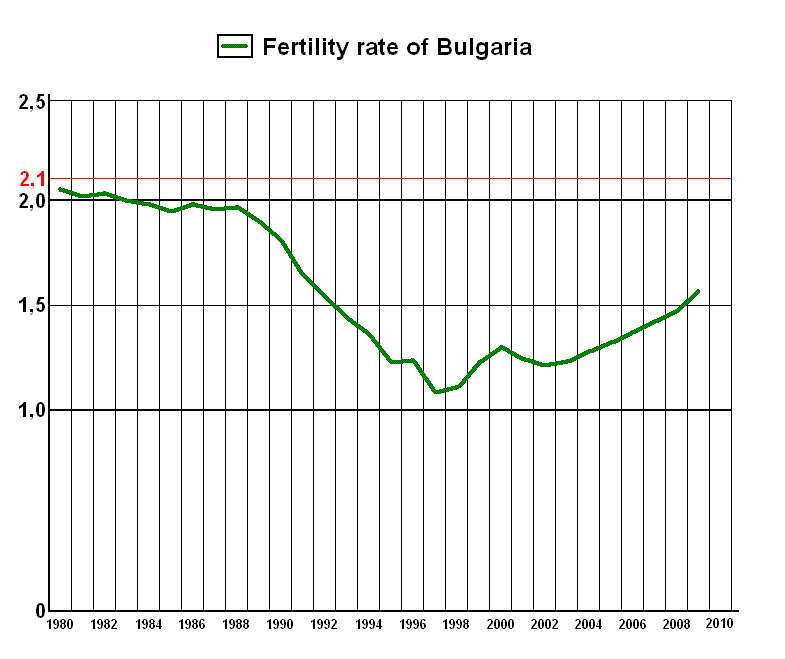
File:Bulgaria map birth rate by region 2014.svg, Birth rate in 2014
File:Bulgaria total fertility rate by region 2013.png, Fertility rate in 2013
File:Bulgaria total fertility rate by region 2014.png, Fertility rate in 2014
File:Графика на раждаемостта и смъртността в България.JPG, Bulgaria's deaths and births (2005–2009).
In 2016 a total of 64,984 live births were recorded in Bulgaria. The country has a crude birth rate of 9.1‰.
Seventy years ago (in the census of 1946), Bulgaria had a crude birth rate of 25,6‰. Ethnic

 :Total population: 74.83 years
:Male: 71.37 years
:Female: 78.39 years (2016-2018 est.)
Average
:Total population: 74.83 years
:Male: 71.37 years
:Female: 78.39 years (2016-2018 est.)
Average
 ;Population:
:6,519,789 (Sept 2021 cens)
:6,919,180 (July 2021 est.)
:7,057,504 (July 2018 est.)
;Ethnic groups:
:Bulgarian 76.9%, Turkish/Balkan Gagauz 8%, Romani 4.4%, other 0.7% (including Russian, Armenian, and Vlach), other (unknown) 10% (2011 est.)
:note: Romani populations are usually underestimated in official statistics and may represent 9–11% of Bulgaria's population
;Languages:
:Bulgarian (official) 76.8%, Balkan Gagauz 8.2%, Romani 3.8%, other 0.7%, unspecified 10.5% (2011 est.)
;Religions:
:Eastern Orthodox 59.4%, Muslim 7.8%, other (including Catholic, Protestant, Armenian Apostolic Orthodox, and Jewish) 1.7%, none 3.7%, unspecified 27.4% (2011 est.)
;Age structure:
;Population:
:6,519,789 (Sept 2021 cens)
:6,919,180 (July 2021 est.)
:7,057,504 (July 2018 est.)
;Ethnic groups:
:Bulgarian 76.9%, Turkish/Balkan Gagauz 8%, Romani 4.4%, other 0.7% (including Russian, Armenian, and Vlach), other (unknown) 10% (2011 est.)
:note: Romani populations are usually underestimated in official statistics and may represent 9–11% of Bulgaria's population
;Languages:
:Bulgarian (official) 76.8%, Balkan Gagauz 8.2%, Romani 3.8%, other 0.7%, unspecified 10.5% (2011 est.)
;Religions:
:Eastern Orthodox 59.4%, Muslim 7.8%, other (including Catholic, Protestant, Armenian Apostolic Orthodox, and Jewish) 1.7%, none 3.7%, unspecified 27.4% (2011 est.)
;Age structure:
 :''0-14 years:'' 14.52% (male 520,190 /female 491,506)
:''15-24 years:'' 9,4% (male 340,306 /female 312,241
:''25-54 years:''42.87% (male 1,538,593 /female 1,448,080)
:''55-64:'' 13.15% (male 433,943 /female 482,784)
:''65 years and over:'' 20.06% (male 562,513 /female 835,065) (2020 est.)
:''0-14 years:'' 14.6% (male 530,219 /female 500,398)
:''15-24 years:'' 9.43% (male 346,588 /female 318,645)
:''25-54 years:'' 43.12% (male 1,565,770 /female 1,477,719)
:''55-64 years:'' 13.3% (male 442,083 /female 496,888)
:''65 years and over:'' 19.54% (male 557,237 /female 821,957) (2018 est.)
;Median age:
:total: 43.7 years. Country comparison to the world: 20
:male: 41.9 years
:female: 45.6 years (2020 est.)
:total: 43 years. Country comparison to the world: 22nd
:male: 41.2 years
:female: 44.9 years (2018 est.)
;Birth rate:
:8.15 births/1,000 population (2021 est.) Country comparison to the world: 218th
:8.5 births/1,000 population (2018 est.) Country comparison to the world: 215th
;Death rate:
:14.52 deaths/1,000 population (2021 est.) Country comparison to the world: 3th
:14.5 deaths/1,000 population (2018 est.) Country comparison to the world: 4th
;Total fertility rate:
:1.49 children born/woman (2021 est.) Country comparison to the world:204th
:1.47 children born/woman (2018 est.) Country comparison to the world: 201st
;Net migration rate:
:-0.29 migrant(s)/1,000 population (2021 est.) Country compy to the world:115
;Population growth rate:
:-0.67% (2021 est.) Country comparison to the world: 229th
;Mother's mean age at first birth:
:27.1 years (2017 est.)
; Dependency ratios:
:total dependency ratio: 56.6 (2020 est.)
:youth dependency ratio: 23 (2020 est.)
:elderly dependency ratio: 33.6 (2020 est.)
:
:''0-14 years:'' 14.52% (male 520,190 /female 491,506)
:''15-24 years:'' 9,4% (male 340,306 /female 312,241
:''25-54 years:''42.87% (male 1,538,593 /female 1,448,080)
:''55-64:'' 13.15% (male 433,943 /female 482,784)
:''65 years and over:'' 20.06% (male 562,513 /female 835,065) (2020 est.)
:''0-14 years:'' 14.6% (male 530,219 /female 500,398)
:''15-24 years:'' 9.43% (male 346,588 /female 318,645)
:''25-54 years:'' 43.12% (male 1,565,770 /female 1,477,719)
:''55-64 years:'' 13.3% (male 442,083 /female 496,888)
:''65 years and over:'' 19.54% (male 557,237 /female 821,957) (2018 est.)
;Median age:
:total: 43.7 years. Country comparison to the world: 20
:male: 41.9 years
:female: 45.6 years (2020 est.)
:total: 43 years. Country comparison to the world: 22nd
:male: 41.2 years
:female: 44.9 years (2018 est.)
;Birth rate:
:8.15 births/1,000 population (2021 est.) Country comparison to the world: 218th
:8.5 births/1,000 population (2018 est.) Country comparison to the world: 215th
;Death rate:
:14.52 deaths/1,000 population (2021 est.) Country comparison to the world: 3th
:14.5 deaths/1,000 population (2018 est.) Country comparison to the world: 4th
;Total fertility rate:
:1.49 children born/woman (2021 est.) Country comparison to the world:204th
:1.47 children born/woman (2018 est.) Country comparison to the world: 201st
;Net migration rate:
:-0.29 migrant(s)/1,000 population (2021 est.) Country compy to the world:115
;Population growth rate:
:-0.67% (2021 est.) Country comparison to the world: 229th
;Mother's mean age at first birth:
:27.1 years (2017 est.)
; Dependency ratios:
:total dependency ratio: 56.6 (2020 est.)
:youth dependency ratio: 23 (2020 est.)
:elderly dependency ratio: 33.6 (2020 est.)
:
 The progressive decrease of the Bulgarian population is hindering economic growth and welfare improvement, and the management measures taken to mitigate the negative consequences do not address the essence of the problem. The Government Program for the period 2017 - 2021 is the first one that aims at overturning the trend. The program also identifies the priority means for achieving this goal: measures to increase the birth rate, reduce youth emigration, and build up regulatory and institutional capacity to implement a modern immigration policy tailored to the needs of the Bulgarian business.
The progressive decrease of the Bulgarian population is hindering economic growth and welfare improvement, and the management measures taken to mitigate the negative consequences do not address the essence of the problem. The Government Program for the period 2017 - 2021 is the first one that aims at overturning the trend. The program also identifies the priority means for achieving this goal: measures to increase the birth rate, reduce youth emigration, and build up regulatory and institutional capacity to implement a modern immigration policy tailored to the needs of the Bulgarian business.

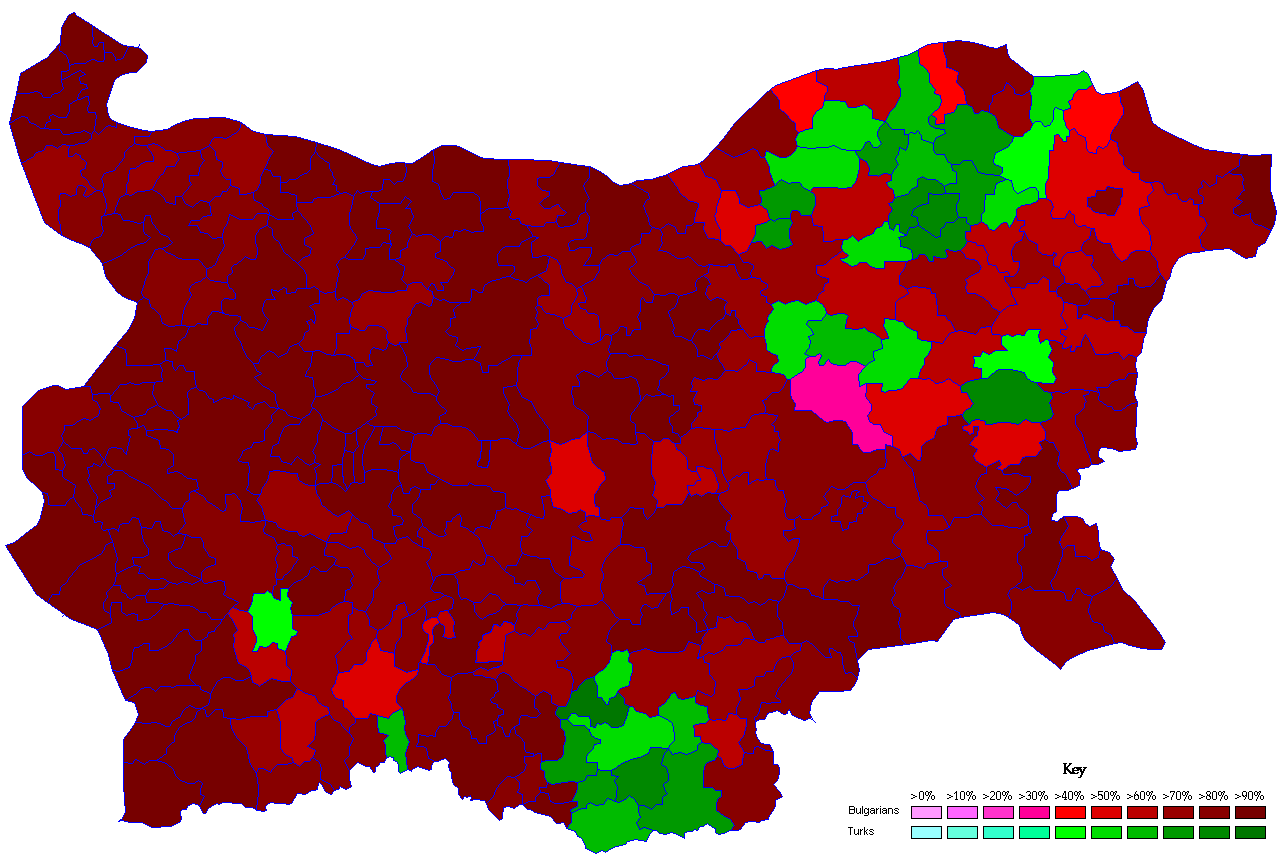
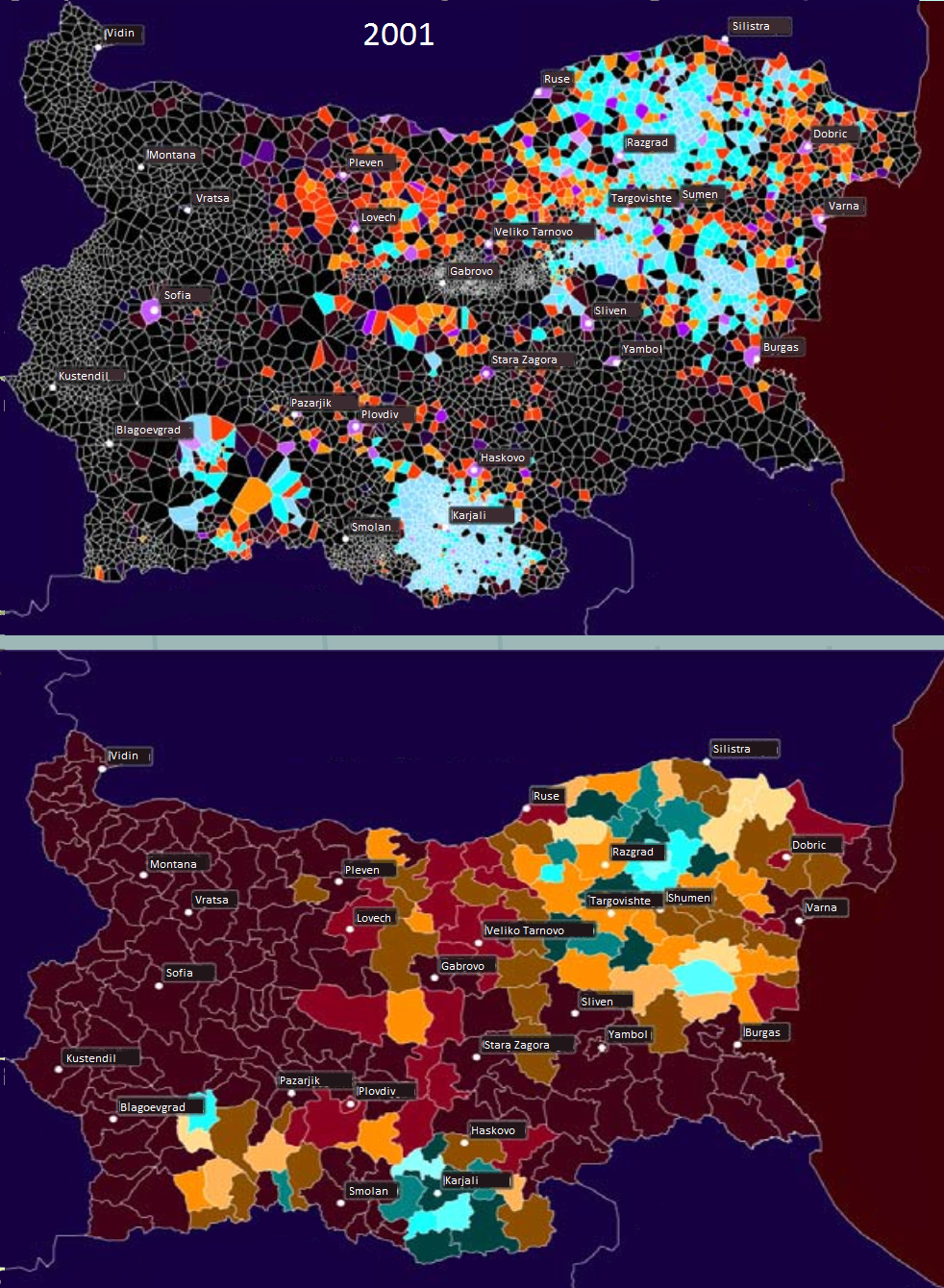
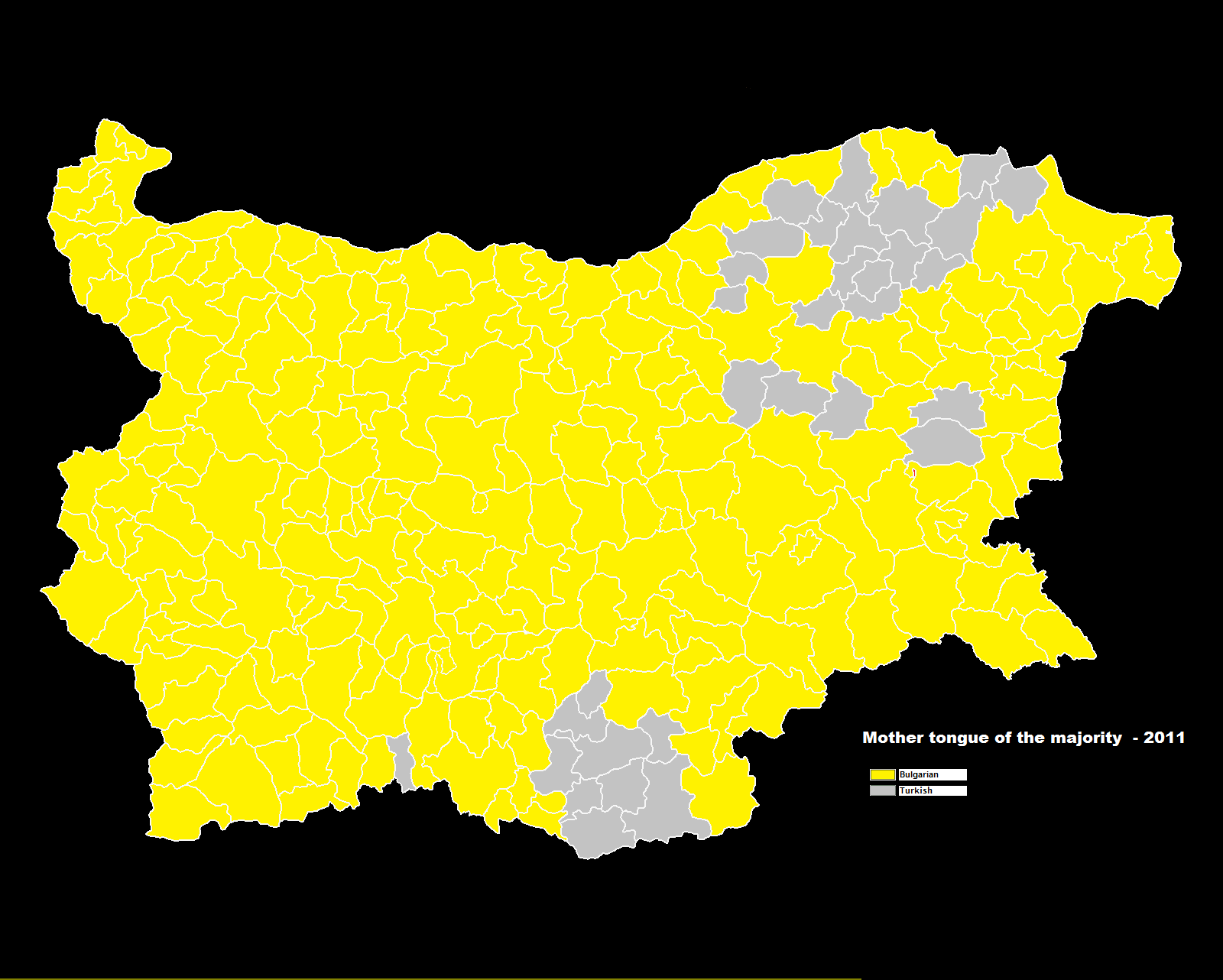 The 2001 census defines an ethnic group as a "community of people, related to each other by origin and language, and close to each other by mode of life and culture"; and one's mother tongue as "the language a person speaks best and usually uses for communication in the family (household)".
According to the 2011 census, among the Bulgarians 99.4% indicate Bulgarian as a mother tongue, 0.3% - Turkish/Balkan gagauz, 0.1% - Roma and 0.1% others; among Turks 96.6% have pointed the Turkish/Balkan Gagauz as a mother tongue and 3.2% - Bulgarian; among the Roma 85% indicate Roma language as a mother tongue, 7.5% - Bulgarian, 6.7% - Turkish/Balkan gagauz and 0.6% - Romanian.
The 2001 census defines an ethnic group as a "community of people, related to each other by origin and language, and close to each other by mode of life and culture"; and one's mother tongue as "the language a person speaks best and usually uses for communication in the family (household)".
According to the 2011 census, among the Bulgarians 99.4% indicate Bulgarian as a mother tongue, 0.3% - Turkish/Balkan gagauz, 0.1% - Roma and 0.1% others; among Turks 96.6% have pointed the Turkish/Balkan Gagauz as a mother tongue and 3.2% - Bulgarian; among the Roma 85% indicate Roma language as a mother tongue, 7.5% - Bulgarian, 6.7% - Turkish/Balkan gagauz and 0.6% - Romanian.
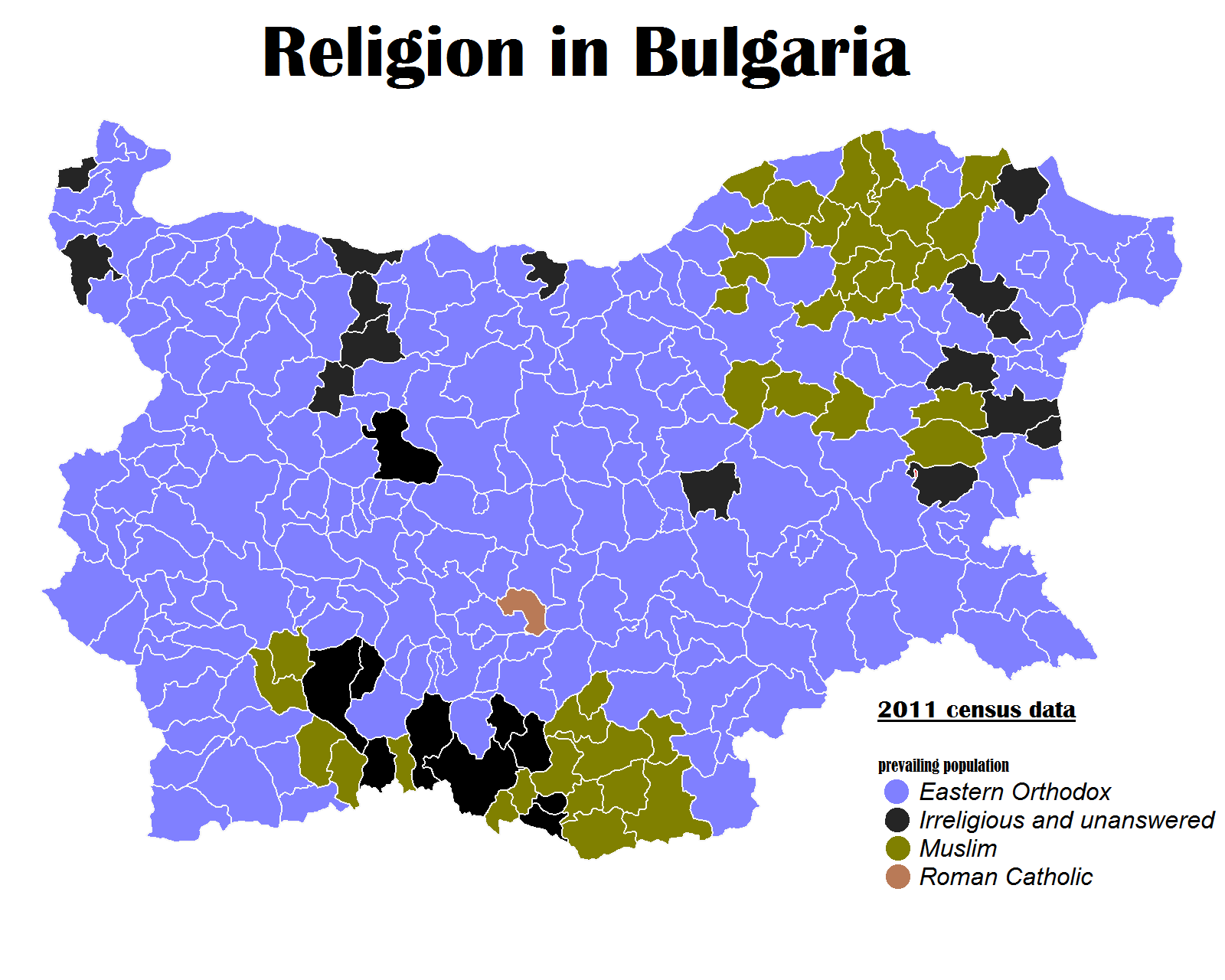
 :
The results of the Bulgarian 2011 Census, in which the indication of answer regarding the question for confession was optional, are as follows:
:
The results of the Bulgarian 2011 Census, in which the indication of answer regarding the question for confession was optional, are as follows:
 The results of the Bulgarian 2001 Census by ethnic groups, the latest census in which the indication of identification (whether by confession or as irreligious) in the question for confession was obligatory, are as follows:
The results of the Bulgarian 2001 Census by ethnic groups, the latest census in which the indication of identification (whether by confession or as irreligious) in the question for confession was obligatory, are as follows:
Bulgarian internal migration 1910.png, Percentage of Bulgarians born in a different municipality of Bulgaria calculated from the total of the ethnic Bulgarians in 1910
Bulgarian refugees 1910.png, Percentage of foreign-born Bulgarians calculated from the total of the ethnic Bulgarians in 1910
Macedonian Bulgarian refugees.png, Percentage of Bulgarians born in Greek Macedonia and North Macedonia in 1946 calculated from the total of the ethnic Bulgarians
Thracian Bulgarian refugees.png, Part of the Bulgarians born in East Thrace,
According to the 2011 census
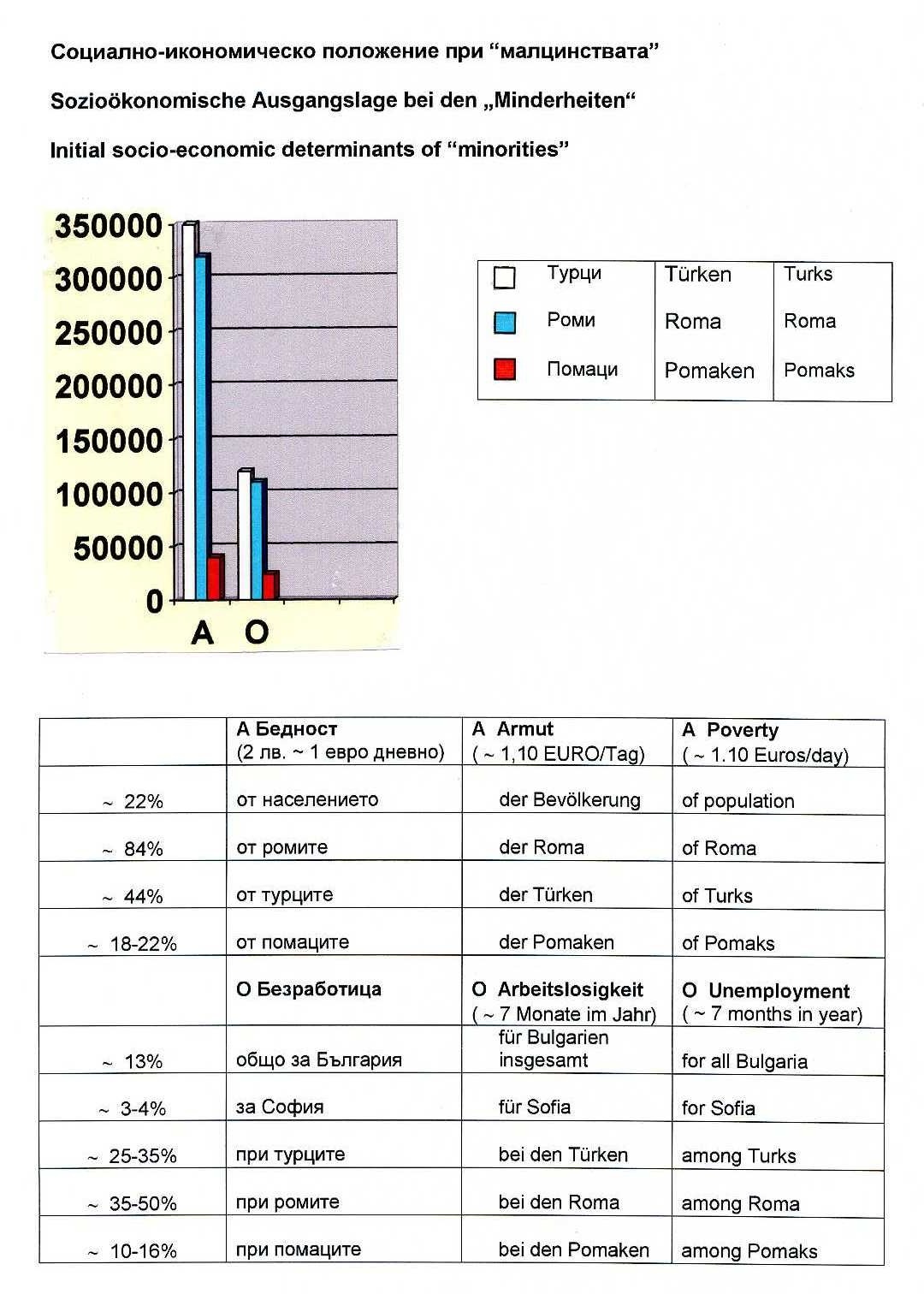 The median unemployment for the country in 2011 was 10.1%.
The number of unemployed people declined to 207 thousand people (or around 6.2% of the population) in 2017.
Most unemployed people are aged 15 to 24 years old.
The unemployment rate in rural areas (around 10.0%) is nearly two times higher than the unemployment rate in urban areas (approximately 5.1%).
Vidin Province has the highest unemployment rate with almost one fifth of its labour force being unemployed. The provinces of Shumen (15.9%), Silistra (12.5%) and Targovishte (12.4%) have also very high unemployment rates.
The median unemployment for the country in 2011 was 10.1%.
The number of unemployed people declined to 207 thousand people (or around 6.2% of the population) in 2017.
Most unemployed people are aged 15 to 24 years old.
The unemployment rate in rural areas (around 10.0%) is nearly two times higher than the unemployment rate in urban areas (approximately 5.1%).
Vidin Province has the highest unemployment rate with almost one fifth of its labour force being unemployed. The provinces of Shumen (15.9%), Silistra (12.5%) and Targovishte (12.4%) have also very high unemployment rates.
2005 Report on European Demography
Eurostat
Annual report of the National Statistics Institute for 2005 regarding population and demographic processes
Urbanization,1910-1946
Bulgarian Subject Files – Social Issues: Minorities
Bulgarians – Species on the Brink
{{Ethnic groups in Bulgaria Society of Bulgaria
Bulgaria
Bulgaria (; bg, България, Bǎlgariya), officially the Republic of Bulgaria,, ) is a country in Southeast Europe. It is situated on the eastern flank of the Balkans, and is bordered by Romania to the north, Serbia and North Macedo ...
, including population density, ethnicity, education level, health of the populace, economic status, religious affiliations and other aspects of the population.
Bulgaria has a high Human Development Index
The Human Development Index (HDI) is a statistic composite index of life expectancy, education (mean years of schooling completed and expected years of schooling upon entering the education system), and per capita income indicators, w ...
of 0.813, ranking 51st in the world in 2018 and holds the 38th position in '' Newsweeks rankings of the world's best countries to live in, measuring health, education, political environment and economic dynamism.
Demographic history
Various estimates have put Bulgaria's medieval population at 1.1 million in 700 AD and 2.6 million in 1365. At the 2011 census, the population inhabiting Bulgaria was 7,364,570 in total, but more recent estimates calculate that the population has declined to 6.9 million. The peak was in 1989, the year when the borders opened after a half of a century of communist regime, when the population numbered 9,009,018. Note: Crude migration change (per 1000) is an extrapolationVital statistics
Vital Statistics 1875 to 1915
The total fertility rate is the number of children born per woman. It is based on fairly good data for the entire period. Sources: Our World in Data andGapminder Foundation
Gapminder Foundation is a non-profit venture registered in Stockholm, Sweden, that promotes sustainable global development and achievement of the United Nations Millennium Development Goals
The Millennium Development Goals (MDGs) were eigh ...
.
Vital statistics 1900–1915
Vital statistics 1916–1940
Vital statistics 1941 to present
Source: National Statistical InstituteCurrent vital statistics
Birth rates and fertility
Bulgarians
Bulgarians ( bg, българи, Bǎlgari, ) are a nation and South Slavic ethnic group native to Bulgaria and the rest of Southeast Europe.
Etymology
Bulgarians derive their ethnonym from the Bulgars. Their name is not completely underst ...
(23,3‰) had a much lower crude birth rate compared to the two largest minorities: Turks (40,9‰) and Roma
Roma or ROMA may refer to:
Places Australia
* Roma, Queensland, a town
** Roma Airport
** Roma Courthouse
** Electoral district of Roma, defunct
** Town of Roma, defunct town, now part of the Maranoa Regional Council
* Roma Street, Brisbane, a ...
(47,2‰). However, it is unlikely that this difference continued since then, as birth rates in the Balkan countries dropped sharply.
Bulgaria has a low total fertility rate of 1.54 children per woman (at the end of 2016). This is up significantly from the late 1990s, but still below replacement and not enough to prevent further population decline, especially with emigration. Provinces with large Roma populations (for example Sliven, Montana and Yambol) tend to have higher fertility rates (and higher death rates) compared to other areas, whereas Turkish fertility is similar to the Bulgarian majority.
Regional differences
As of 2017, the municipality ofNikolaevo
Nikolaevo ( bg, Николаево ) is a small town in Stara Zagora Province, South-central Bulgaria
Bulgaria (; bg, България, Bǎlgariya), officially the Republic of Bulgaria,, ) is a country in Southeast Europe. It is situat ...
has the highest crude birth rate with 18.6‰, followed by Tvarditsa (16.7‰) and Kaynardzha (15.7‰). All these municipalities have relatively large Romani
Romani may refer to:
Ethnicities
* Romani people, an ethnic group of Northern Indian origin, living dispersed in Europe, the Americas and Asia
** Romani genocide, under Nazi rule
* Romani language, any of several Indo-Aryan languages of the Roma ...
populations.
On the other hand, the municipalities of Georgi Damyanovo, Banite and Nevestino have a extremely low birth rates. These municipalities are almost exclusively inhabited by ethnic Bulgarians.
Teenage pregnancy
Bulgaria has one of the highest share of teenage pregnancy in Europe. Nevertheless, this number is declining rapidly in recent years. The ten municipalities with the largest absolute number of teenage mothers are: Sliven (373), Sofia (339), Plovdiv (245), Pazardzhik (161), Stara Zagora (141),Nova Zagora
Nova Zagora ( bg, Нова Загора ) is a town located in the southeastern plains of Bulgaria in Sliven Province. It is the administrative centre of Nova Zagora Municipality. As of December 2009, the town had a population of 19,562 inhabit ...
(131), Burgas (108), Yambol (106), Haskovo (96) and Varna (86).
Life expectancy at birth
 :Total population: 74.83 years
:Male: 71.37 years
:Female: 78.39 years (2016-2018 est.)
Average
:Total population: 74.83 years
:Male: 71.37 years
:Female: 78.39 years (2016-2018 est.)
Average life expectancy
Life expectancy is a statistical measure of the average time an organism is expected to live, based on the year of its birth, current age, and other demographic factors like sex. The most commonly used measure is life expectancy at birth ...
at age 0 of the total population.
Kardzhali Province
Kardzhali Province ( bg, Област Кърджали, Oblast Kărdžali, tr, Kırcaali ili) is a province of southern Bulgaria, neighbouring Greece with the Greek regional units of Xanthi, Rhodope, and Evros to the south and east. It is 3 ...
and Sofia City
Sofia ( ; bg, София, Sofiya, ) is the capital and largest city of Bulgaria. It is situated in the Sofia Valley at the foot of the Vitosha mountain in the western parts of the country. The city is built west of the Iskar river, and has ...
have the highest life expectancy with 76.6 years for both sexes. The lowest life expectancy is recorded in the Northwestern provinces like Montana (72.7 years), Vratsa (72.8 years) and Vidin (72.9 years).
Infant mortality rate
:Total: 5.8 deaths/1,000 live births (2018) :Male: 6.2 deaths/1,000 live births (2018) :Female: 5.3 deaths/1,000 live births (2018)Projections
The following forecast for the future population is an official estimate of the National Statistical Institute of Bulgaria.Demographic statistics
Demographic statistics according to the World Population Review. *One birth every 8 minutes *One death every 5 minutes *One net migrant every 111 minutes *Net loss of one person every 11 minutes Demographic statistics according to the CIA World Factbook, unless otherwise indicated.potential support ratio
The potential support ratio (PSR) is the number of people age 15–64 per one older person aged 65 or older. This ratio describes the burden placed on the working population ( unemployment and children are not considered in this measure) by the n ...
: 3 (2020 est.)
;Urbanization:
:urban population: 75.7% of total population (2020)
.rate of urbanization: -0.22% annual rate of change (2015-20 est.)
:potential support ratio: 3.3 (2015 est.)
;Life expectancy at birth:
:total population: 75.3 years. Country comparison to the world: 122th
:male: 72.08 years
:female: 78.73 years (2021 est.)
;Literacy:
definition: age 15 and over can read and write (2015 est.)
:total population: 98.4%
:male: 98.7%
:female: 98.1% (2015 est.)
;School life expectancy (primary to tertiary education):
:total: 14 years
:male: 14 years
:female: 14 years (2016)
;Unemployment, youth ages 15–24:
:total: 12.7%. Country comparison to the world: 108th
:male: 13.2%
:female: 11.9% (2018 est.)
Sex ratio
Of the total 7,364,570 as of 2011, 3,586,571 aremale
Male (symbol: ♂) is the sex of an organism that produces the gamete (sex cell) known as sperm, which fuses with the larger female gamete, or ovum, in the process of fertilization.
A male organism cannot reproduce sexually without access to ...
s and 3,777,999 are female
Female ( symbol: ♀) is the sex of an organism that produces the large non-motile ova (egg cells), the type of gamete (sex cell) that fuses with the male gamete during sexual reproduction.
A female has larger gametes than a male. Fema ...
s, or there are 1,053 women for every 1,000 men.
Demographic policies
 The progressive decrease of the Bulgarian population is hindering economic growth and welfare improvement, and the management measures taken to mitigate the negative consequences do not address the essence of the problem. The Government Program for the period 2017 - 2021 is the first one that aims at overturning the trend. The program also identifies the priority means for achieving this goal: measures to increase the birth rate, reduce youth emigration, and build up regulatory and institutional capacity to implement a modern immigration policy tailored to the needs of the Bulgarian business.
The progressive decrease of the Bulgarian population is hindering economic growth and welfare improvement, and the management measures taken to mitigate the negative consequences do not address the essence of the problem. The Government Program for the period 2017 - 2021 is the first one that aims at overturning the trend. The program also identifies the priority means for achieving this goal: measures to increase the birth rate, reduce youth emigration, and build up regulatory and institutional capacity to implement a modern immigration policy tailored to the needs of the Bulgarian business.
Ethnic groups
The following table shows the ethnic composition of all Provinces of Bulgaria according to the 2011 census(% from the declared):
Languages
 The 2001 census defines an ethnic group as a "community of people, related to each other by origin and language, and close to each other by mode of life and culture"; and one's mother tongue as "the language a person speaks best and usually uses for communication in the family (household)".
According to the 2011 census, among the Bulgarians 99.4% indicate Bulgarian as a mother tongue, 0.3% - Turkish/Balkan gagauz, 0.1% - Roma and 0.1% others; among Turks 96.6% have pointed the Turkish/Balkan Gagauz as a mother tongue and 3.2% - Bulgarian; among the Roma 85% indicate Roma language as a mother tongue, 7.5% - Bulgarian, 6.7% - Turkish/Balkan gagauz and 0.6% - Romanian.
The 2001 census defines an ethnic group as a "community of people, related to each other by origin and language, and close to each other by mode of life and culture"; and one's mother tongue as "the language a person speaks best and usually uses for communication in the family (household)".
According to the 2011 census, among the Bulgarians 99.4% indicate Bulgarian as a mother tongue, 0.3% - Turkish/Balkan gagauz, 0.1% - Roma and 0.1% others; among Turks 96.6% have pointed the Turkish/Balkan Gagauz as a mother tongue and 3.2% - Bulgarian; among the Roma 85% indicate Roma language as a mother tongue, 7.5% - Bulgarian, 6.7% - Turkish/Balkan gagauz and 0.6% - Romanian.
Religion
Bulgaria's traditional religion according to the constitution is theOrthodox Christianity
Orthodoxy (from Greek: ) is adherence to correct or accepted creeds, especially in religion.
Orthodoxy within Christianity refers to acceptance of the doctrines defined by various creeds and ecumenical councils in Antiquity, but different Chu ...
, while Bulgaria is a secular state too. Since the last two censuses (2001 and 2011) provide widely divergent results, they are both shown in the table below. It is noteworthy that over a fifth of the population chose not to respond to this question in the 2011 census.

 The results of the Bulgarian 2001 Census by ethnic groups, the latest census in which the indication of identification (whether by confession or as irreligious) in the question for confession was obligatory, are as follows:
The results of the Bulgarian 2001 Census by ethnic groups, the latest census in which the indication of identification (whether by confession or as irreligious) in the question for confession was obligatory, are as follows:
Migration
In relation to internal migration, according to the 1910 census, 300,000 or almost 10% of the ethnic Bulgarians were born in another Bulgarian municipality than the one they were enumerated in. The same data shows that the foreign-born ethnic Bulgarians numbered 78,000, or 2% of them, most numerous of whom were the 61,000 Ottoman-born, 9,000 Romanian-born and by less than 2,000 Austro-Hungarian, Serbian and Russian-born. By the 1926 census, there had been 253,000 refugees with granted households and land or citizenship but with many more in towns of uncertain number. 35% came from Eastern Thrace, 30% came from Greek Macedonia, another 18% from Western Thrace, 8% fromDobruja
Dobruja or Dobrudja (; bg, Добруджа, Dobrudzha or ''Dobrudža''; ro, Dobrogea, or ; tr, Dobruca) is a historical region in the Balkans that has been divided since the 19th century between the territories of Bulgaria and Romania. I ...
, 4% from the Western Outlands, 3% from Asia Minor
Anatolia, tr, Anadolu Yarımadası), and the Anatolian plateau, also known as Asia Minor, is a large peninsula in Western Asia and the westernmost protrusion of the Asian continent. It constitutes the major part of modern-day Turkey. The re ...
, and 2% from North Macedonia
North Macedonia, ; sq, Maqedonia e Veriut, (Macedonia before February 2019), officially the Republic of North Macedonia,, is a country in Southeast Europe. It gained independence in 1991 as one of the successor states of Socialist Feder ...
. They constituted 6% of the country's population. In 1940, 70,000 Bulgarians were exchanged from Northern Dobruja. The total number of refugees in 1878-1940 is estimated at between 700,000 and 1,200,000.
West Thrace
Western Thrace or West Thrace ( el, �υτικήΘράκη, '' ytikíThráki'' ; tr, Batı Trakya; bg, Западна/Беломорска Тракия, ''Zapadna/Belomorska Trakiya''), also known as Greek Thrace, is a geographic and historic ...
and Asia Minor
Anatolia, tr, Anadolu Yarımadası), and the Anatolian plateau, also known as Asia Minor, is a large peninsula in Western Asia and the westernmost protrusion of the Asian continent. It constitutes the major part of modern-day Turkey. The re ...
in 1946 calculated from the total of the ethnic Bulgarians
Danubian Bulgarian refugees.png, Part of the Bulgarians born in Northern Dobruja, Romania
Romania ( ; ro, România ) is a country located at the crossroads of Central Europe, Central, Eastern Europe, Eastern, and Southeast Europe, Southeastern Europe. It borders Bulgaria to the south, Ukraine to the north, Hungary to the west, S ...
and Serbia
Serbia (, ; Serbian: , , ), officially the Republic of Serbia ( Serbian: , , ), is a landlocked country in Southeastern and Central Europe, situated at the crossroads of the Pannonian Basin and the Balkans. It shares land borders with Hu ...
in 1946 calculated from the total of the ethnic Bulgarians
Bulgarian refugees.png, Foreign born as a part of the ethnic Bulgarians in 1946
Russia
Russia (, , ), or the Russian Federation, is a transcontinental country spanning Eastern Europe and Northern Asia. It is the largest country in the world, with its internationally recognised territory covering , and encompassing one-ei ...
n citizens are the most numerous foreigners - 11 991, followed by 8 444 EU citizens (UK- 2 605, Greece - 1 253, Germany- 848, Poland - 819 and Italy - 456), citizens of Ukraine
Ukraine ( uk, Україна, Ukraïna, ) is a country in Eastern Europe. It is the second-largest European country after Russia, which it borders to the east and northeast. Ukraine covers approximately . Prior to the ongoing Russian inva ...
- 3 064, North Macedonia
North Macedonia, ; sq, Maqedonia e Veriut, (Macedonia before February 2019), officially the Republic of North Macedonia,, is a country in Southeast Europe. It gained independence in 1991 as one of the successor states of Socialist Feder ...
- 1 091, Moldova
Moldova ( , ; ), officially the Republic of Moldova ( ro, Republica Moldova), is a landlocked country in Eastern Europe. It is bordered by Romania to the west and Ukraine to the north, east, and south. The unrecognised state of Transnistri ...
- 893 and Serbia
Serbia (, ; Serbian: , , ), officially the Republic of Serbia ( Serbian: , , ), is a landlocked country in Southeastern and Central Europe, situated at the crossroads of the Pannonian Basin and the Balkans. It shares land borders with Hu ...
- 569. 22.8% of them are from Asia, mostly from Turkey. Those with dual Bulgarian and other citizenship were 22 152, or 0.3% of the population. Of them persons with Bulgarian and Russian citizenship were 5 257 (23.7%), followed by persons with Bulgarian and Turkish citizenship - 4 282 (19.3%), Bulgarian and citizenship of the USA- 1 725 (7.8%). There are at least 17,527 Refugees of the Syrian Civil War with applications in Bulgaria. In 2001-2015 185,447 people applied for Bulgarian citizenship and 116,222 were provided with. 113,647 were granted on grounds of proven Bulgarian ancestry, including 59,968 North Macedonia citizens. 29,218 were Moldova
Moldova ( , ; ), officially the Republic of Moldova ( ro, Republica Moldova), is a landlocked country in Eastern Europe. It is bordered by Romania to the west and Ukraine to the north, east, and south. The unrecognised state of Transnistri ...
n citizens, 5930 Ukrainians, 5374 Serbians, 5194 Russians, 3840 Israeli, 2192 Albanians, 692 Turks and others. In 2016, 12,880 foreigners were naturalized, including 6196 Macedonians.
Population by country of birth:
Foreigners by nationality:
Age structure
:0–14 years: 13.2% :15–65 years: 68.3% :65 years and over: 18.5% (Census 2011) At the 2011 census the largest decadal age group of the identified asRomani people
The Romani (also spelled Romany or Rromani , ), colloquially known as the Roma, are an Indo-Aryan peoples, Indo-Aryan ethnic group, traditionally nomadic Itinerant groups in Europe, itinerants. They live in Europe and Anatolia, and have Ro ...
is the 0–9 years old or 21% of them, the same age group accounted for 10% of the Turks and 7% of the Bulgarians
Bulgarians ( bg, българи, Bǎlgari, ) are a nation and South Slavic ethnic group native to Bulgaria and the rest of Southeast Europe.
Etymology
Bulgarians derive their ethnonym from the Bulgars. Their name is not completely underst ...
. Experts estimate that the Romani in some provinces make up 40% of all aged between 0 and 9 years. Amongst those who did not answer the question on
ethnic group lowest is the share of people aged 60+ years.
Bulgarian children constitute the majority of all children in 23 out of 28 provinces. They constitute more than ninety percent of all children in two provinces: Sofia (city) (92%) and Pernik Province (90%).
Turkish children constitute the majority in Kardzhali Province
Kardzhali Province ( bg, Област Кърджали, Oblast Kărdžali, tr, Kırcaali ili) is a province of southern Bulgaria, neighbouring Greece with the Greek regional units of Xanthi, Rhodope, and Evros to the south and east. It is 3 ...
(68% of self-declared) and Razgrad Province (50% of self-declared); they also constitute the largest group of all children in Silistra Province (43%).
Roma children constitute 12% of all children in Bulgaria and more than a quarter in three provinces: Montana (29%), Sliven (28%) and Yambol (27%).
Bulgaria is ageing rapidly, especially in some remote rural areas.
The ageing of the population leads to an increase of the median age. The median age is 43.6 as of 2017, up from 40.4 years in 2001.
Education
Over 98% of the population is literate, the males being more literate than the females. According to the 2011 census, about 112,778 people aged nine or more are illiterate. There are considerable differences in the share of illiterate persons amongst the three main ethnic groups. Amongst the Bulgarian ethnic group the share of illiterate is 0.5%, amongst the Turkish - 4.7% and amongst the Roma ethnic group - 11.8%. About 81 thousand people aged seven or more never visited school.Unemployment
 The median unemployment for the country in 2011 was 10.1%.
The number of unemployed people declined to 207 thousand people (or around 6.2% of the population) in 2017.
Most unemployed people are aged 15 to 24 years old.
The unemployment rate in rural areas (around 10.0%) is nearly two times higher than the unemployment rate in urban areas (approximately 5.1%).
Vidin Province has the highest unemployment rate with almost one fifth of its labour force being unemployed. The provinces of Shumen (15.9%), Silistra (12.5%) and Targovishte (12.4%) have also very high unemployment rates.
The median unemployment for the country in 2011 was 10.1%.
The number of unemployed people declined to 207 thousand people (or around 6.2% of the population) in 2017.
Most unemployed people are aged 15 to 24 years old.
The unemployment rate in rural areas (around 10.0%) is nearly two times higher than the unemployment rate in urban areas (approximately 5.1%).
Vidin Province has the highest unemployment rate with almost one fifth of its labour force being unemployed. The provinces of Shumen (15.9%), Silistra (12.5%) and Targovishte (12.4%) have also very high unemployment rates.
Other statistics
Home ownership
According to Eurostat, 82.3% per cent of the population live in privately owned and owner-occupied homes, ranking it as 12th highest in ownership globally. It is down from a recent peak of 87.6% in 2008, and has been steadily falling since.Internet penetration
The number of Internet users has increased rapidly since 2000—from 430,000 their number grew to 1.55 million in 2004, and 3.4 million (48 per cent penetration rate) in 2010. Bulgaria has the third-fastest average Broadband Internet speed in the world after South Korea and Romania with an average speed of 1,611 kbit/s.Mobile phone adoption
Currently there are three active mobile phone operators— Mtel, Telenor and Vivacom, Mtel is the largest one with 5.2 million users as of 2010, Telenor has 3,9 million as of 2007 and Vivacom over 1 million.HIV
Bulgaria's HIV rate is among the lowest in the world, being 0.1% or 3,800 infected as of 2009.Urbanization
Most Bulgarians (72.5 per cent) reside in urban areas. Approximately one-sixth of them live in Sofia, which has a population exceeding 1,200,000 people. :Urban population: 5,338,261 or 72.5% of total population (Census 2011) :Rural: 2,026,309 or 27.5% :Rate of urbanization: -0.3% annual rate of change (2005–10 est.)See also
*Immigration to Bulgaria
A process of immigration of ethnic non-Bulgarians to Bulgaria began after the country's liberation from Ottoman rule and the restoration of the Bulgarian state in 1878. The first wave of immigrants, mainly from Central and Eastern Europe, brought ...
* Immigration to Europe
Immigration to Europe has a long history, but increased substantially in the later 20th century.
Western Europe countries, especially, saw high growth in immigration after World War II and many European nations today (particularly those of the ...
* List of countries by immigrant population
* Bulgaria
Bulgaria (; bg, България, Bǎlgariya), officially the Republic of Bulgaria,, ) is a country in Southeast Europe. It is situated on the eastern flank of the Balkans, and is bordered by Romania to the north, Serbia and North Macedo ...
* Ageing of Europe
Notes
References
External links
2005 Report on European Demography
Eurostat
Annual report of the National Statistics Institute for 2005 regarding population and demographic processes
Urbanization,1910-1946
Bulgarian Subject Files – Social Issues: Minorities
Blinken Open Society Archives
Blinken Open Society Archives (abbreviated as Blinken OSA) is an archival repository and laboratory that aims to explore new ways of assessing, contextualizing, presenting, and making use of archival documents both in a professional and a conscio ...
, Budapest
Bulgarians – Species on the Brink
{{Ethnic groups in Bulgaria Society of Bulgaria